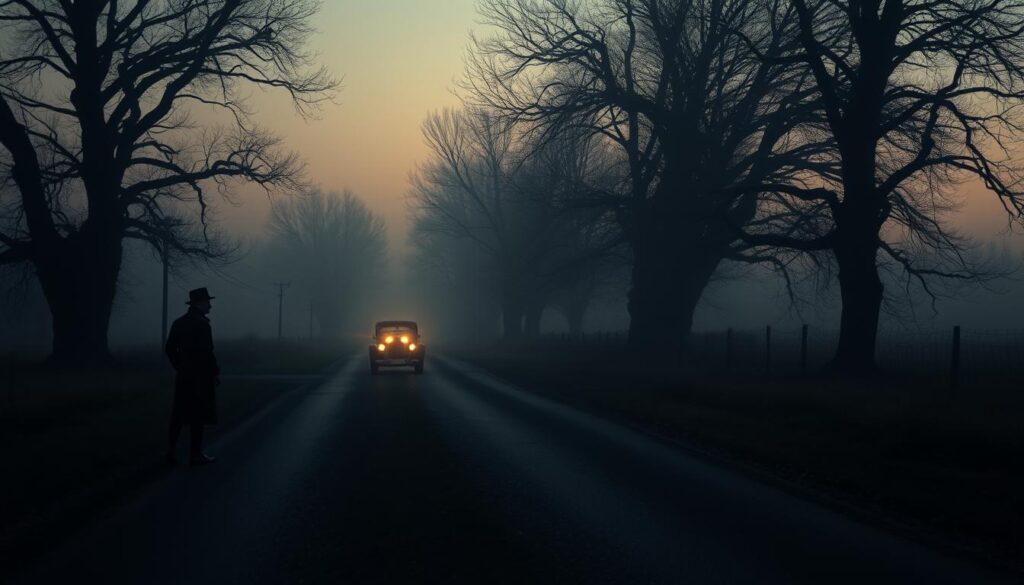Ever wondered why ghostly hitchhiker stories keep coming back? They’ve been around for ages, grabbing our attention and making us shiver. The tale of the vanishing hitchhiker in the UK is part of a bigger collection of urban legends. These stories have grown over time, leaving us with a mix of mystery and awe.
The story is simple yet chilling: a driver picks up a hitchhiker, only to have them disappear. This has been happening since the 1600s in Sweden. These tales have made their way into today’s folklore, showing us our deepest fears and everyday experiences. Now, people are still drawn to these stories, looking for places where these ghosts are said to appear.
Key Takeaways
- The Vanishing Hitchhiker legend has multiple versions, each with unique cultural significance.
- This urban legend has evolved since its first recorded appearance in 1602.
- Surveys show a variety of ghostly apparitions associated with these tales.
- Folklore studies classify the Vanishing Hitchhiker story under typology E332.3.3.1.
- The decline of hitchhiking has shifted perceptions and adaptations of the legend.
- Media portrayals have heightened awareness of hitchhiking dangers, further enriching the legend.
Introduction to the Vanishing Hitchhiker Legend
The vanishing hitchhiker story is a fascinating part of British folklore and urban legends. It tells of a hitchhiker who vanishes from a car without a clue. This tale leaves behind eerie signs, like a lost jacket or an unanswered question.
This legend mixes the supernatural with everyday life, sparking curiosity and fear. It’s a story that has been passed down through generations. It shows how different cultures deal with loss and mystery.
This legend is a key part of British folklore, revealing deep societal fears. It helps us understand urban legends and the human experience. The vanishing hitchhiker story is a thrilling mix of reality and the unknown, captivating many.
The eerie tale of the Vanishing Hitchhiker: United Kingdom

The vanishing hitchhiker UK story is a favorite among many. It’s filled with mystery and local twists. These tales often happen on quiet roads, where a simple ride turns into a haunting mystery.
Drivers pick up a hitchhiker who might share a touching story or just enjoy the ride. But then, the hitchhiker vanishes. You might look away for a second, and they’re gone. Sometimes, their clothes or personal items are found near graves, adding to the mystery.
This legend is a big part of British folklore. It makes people think about death, memory, and loss. The vanishing hitchhiker gives us chills and reminds us of the unknown, becoming a key part of our stories.
Origins of the Vanishing Hitchhiker Story
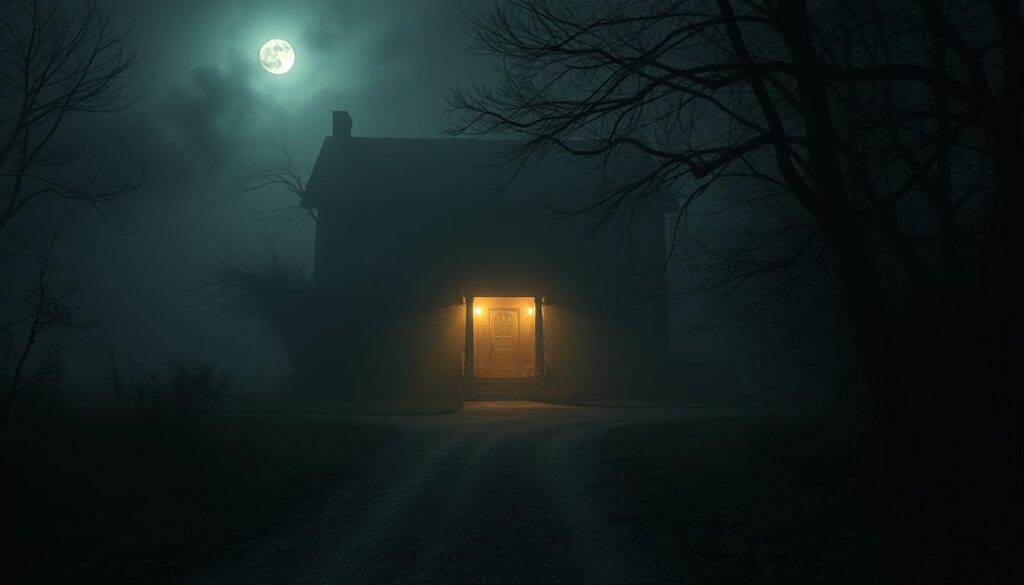
The legend of the vanishing hitchhiker has deep roots, with its origins linking to diverse cultures around the world. Accounts of similar experiences date back to the 1870s. This shows a shared fascination with spectral encounters.
One of the earliest references is in a 400-year-old Swedish manuscript by Joen Petri Klint. This ghostly tale mirrors the many variations of the mystery of the vanishing house that echo through time and geography.
Across nations, the tales of vanishing hitchhikers show remarkable similarities, from Tsarist Russia to Korea and America. Each area has its own version, yet the core theme remains universal: a brief encounter with a phantom on the roadside. These stories often highlight social fears and the supernatural beliefs that vary between cultures, contributing to the rich history of vanishing hitchhikers.
The adaptability of these narratives demonstrates their longevity, as they evolve while retaining their essence. Whether told around a campfire or shared on social media, the tales invite listeners to ponder the unexplained, fueling curiosity about the unknown realms of life and death.
Variations of the Vanishing Hitchhiker Across Cultures
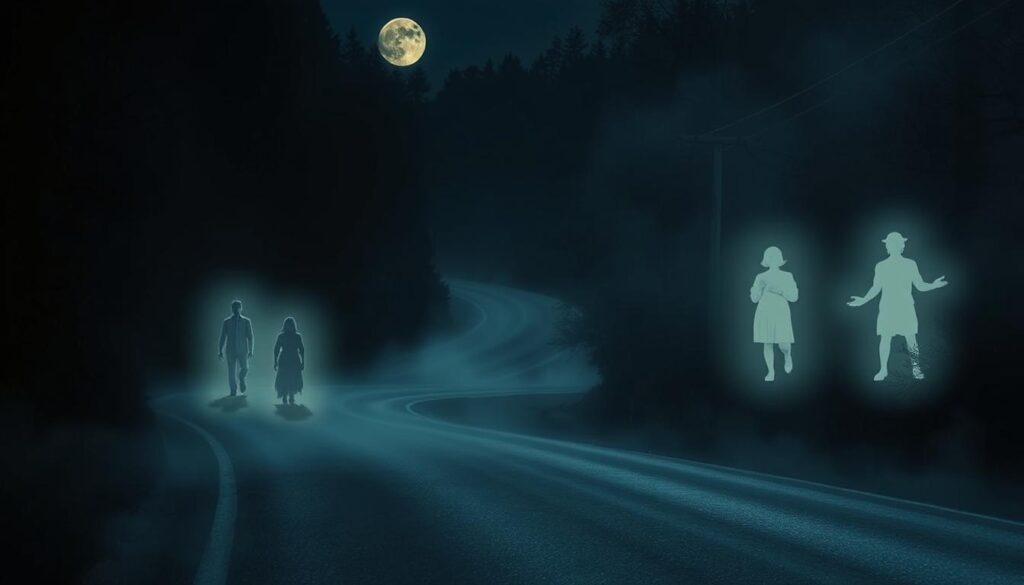
Supernatural urban legends are known for changing as they move from one culture to another. The vanishing hitchhiker legend is a great example of this. It shows how local beliefs can change these scary stories. Often, the hitchhiker’s belongings are found on a grave, linking the living to the dead.
In some stories, the hitchhiker warns of future dangers. This adds a sense of mystery and fear. For example, Hawaiian tales include gods like Pele, giving the legend a unique twist. These changes make the story richer and show how folk tales reflect local experiences and fears.
The tale has traveled far, from Shillong’s rare hitchhiking to the United States’ rich storytelling. It started in Ethiopia, showing its deep roots in folklore. Its ability to adapt shows a storytelling tradition that spans generations and cultures.
The Eerie Flannan Isles Lighthouse Keepers

The Flannan Isles mystery is a chilling tale of three lighthouse keepers who vanished in December 1900. Their disappearance has sparked endless curiosity and fear. It’s linked to other eerie tales in the UK. Visitors to the isolated lighthouse often feel a strange, unsettling feeling.
Many theories try to explain what happened to the keepers. Some believe a violent storm took their lives. Others think it might have been something supernatural. The Flannan Isles’ isolation makes the mystery even more eerie, fueling endless speculation.
This mystery shares similarities with the Vanishing Hitchhiker tale. Both stories deal with isolation and mysterious disappearances. Each retelling of the Flannan Isles story adds to its legend, captivating researchers and ghost story fans.
Exploring the Flannan Isles’ history and legend reveals how eerie tales can mix reality with the supernatural. The keepers’ disappearance is still a mystery, making this story a fascinating enigma.
Significance of Ghost Stories in British Folklore

Ghost stories in the UK are a big part of British folklore. They help us think about our culture and learn important lessons. These stories let us face our fears and question what’s right and wrong.
These tales are a big deal because they tell us about our history and traditions. Stories like the ghost of a priest in Witney or the White Lady of Minster Lovell Hall are very meaningful. They make us feel connected to our community and our past.
Ghost stories have been a key part of British culture for a long time. They keep our heritage alive by telling us about our history in a spooky way. The Vanishing Hitchhiker and the cloaked woman on West End are just a few examples. They show how our stories connect us to the past and to each other.
Ghost stories in the UK help us understand and keep our culture alive. They link us to our ancestors through their stories. The Vanishing Hitchhiker legend shows how these tales can change but still capture our imagination. Folklore is important because it helps us face our fears and celebrate our shared human experiences.
Associated Stories and Shared Experiences
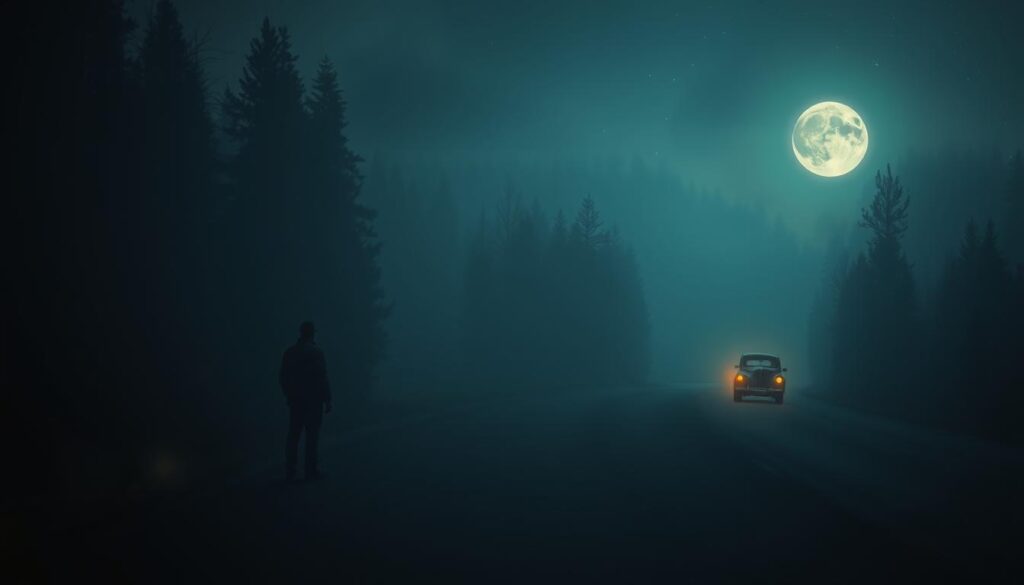
Many ghost stories add to the mystery of the Vanishing Hitchhiker legend. People all over the UK have had similar experiences. These stories show a common belief in the supernatural.
These shared tales not only link the people telling them but also add local twists. Whether it’s a friend’s story of picking up a hitchhiker or a family member’s chilling encounter, they add to the folklore. These stories gain authenticity from their local details.
Online platforms are key for sharing these spooky tales. They help communities form around these stories. This keeps the Vanishing Hitchhiker legend alive in British folklore, with stories passed down through generations. Each retelling brings new life to the mystery, reminding us of the unknown that follows us on our travels.
Research on Vanishing Hitchhiker Encounters
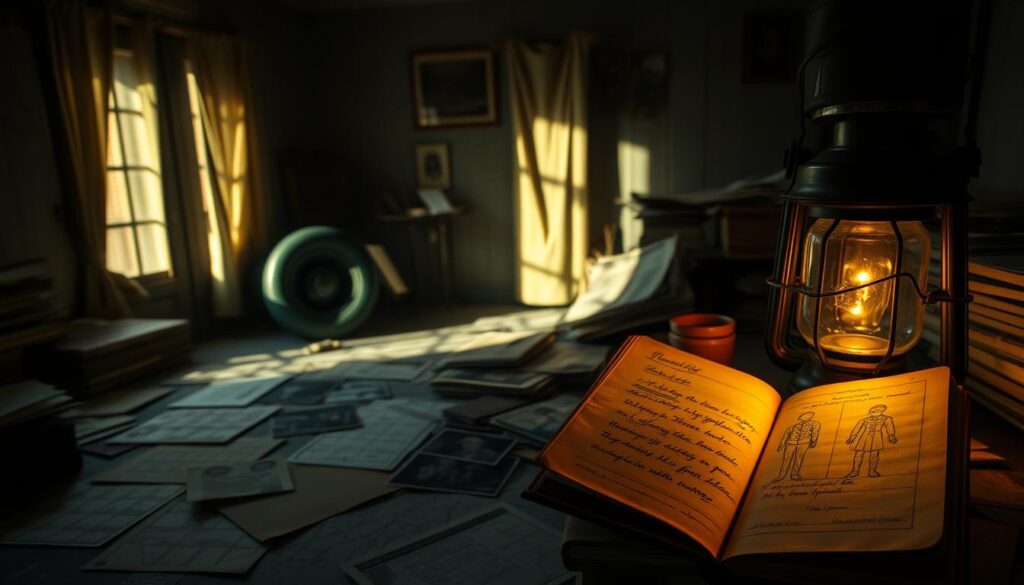
The Vanishing Hitchhiker phenomenon has caught the eye of many researchers. They’ve dug deep into urban legends. These stories often happen on roads with sad histories or where accidents are common.
Sean Tudor found that many road ghosts in Britain are women or young girls. This fact makes the stories more touching. Characters like the Red-Headed Hitchhiker are known for their mischief, unlike figures like Resurrection Mary.
People like Clay Fees have shared their scary experiences. He saw a ghostly hitchhiker on an Oklahoma back road. The hitchhiker glowed and had haunting eyes, making Clay wonder if it was real.
Places like Interstate 4 near Sanford, Florida, are known for strange occurrences. Route 66 also has many haunted sites. These places draw those who love folklore and personal stories.
Modern Retellings and Media Adaptations
The Vanishing Hitchhiker’s tale has moved from old stories to today’s media. It has caught the interest of many. This story is a key part of modern ghost stories in the UK, leading to many adaptations.
In today’s world, the Vanishing Hitchhiker’s story is still captivating. You might see it in:
- Horror films with characters like the ghostly hitchhiker.
- Television dramas that delve into urban legends and supernatural events.
- Books that give classic ghost stories a new twist.
- Documentaries that look into hauntings and legends from today’s view.
This story’s spooky side gets people feeling strong emotions. It shows how old tales can change but keep their core mystery and spookiness. The interest in the Vanishing Hitchhiker shows our society loves the unknown. It shows how we’ve changed and what we expect from stories.
The Psychological Aspect of Hitchhiker Tales
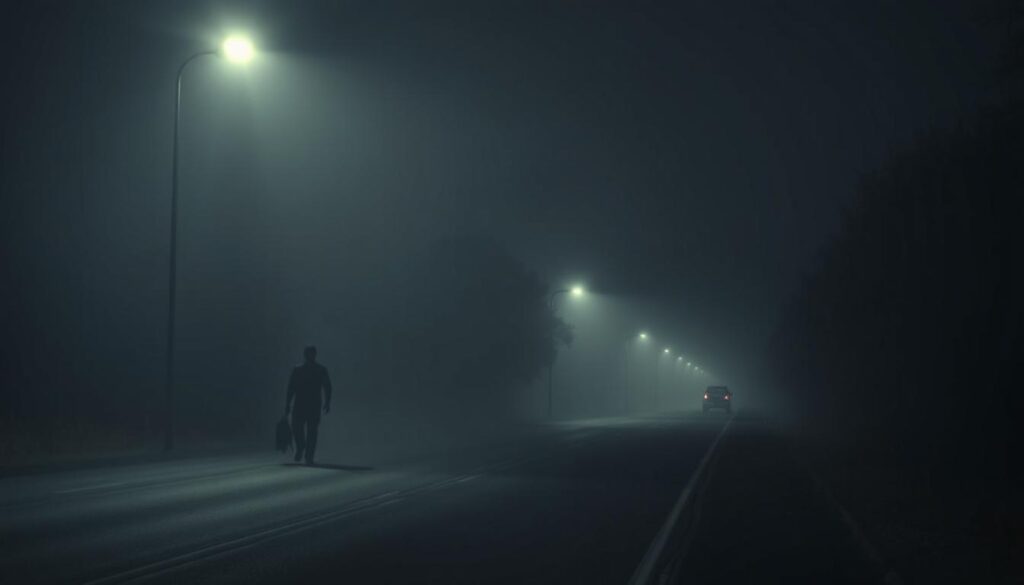
The Vanishing Hitchhiker urban legend explores psychological aspects urban legends. It captures our fear and curiosity. Hearing about a ghostly hitchhiker makes us think about safety and the unknown.
These stories reflect our deep-seated fears and doubts. They show how our collective anxieties are echoed in these tales. They make us think about life’s big questions, like death and what comes after.
Urban legends mix truth with fiction, making them unforgettable. They use real events to create a story that sticks with us. This blend of fact and fantasy makes these tales emotionally powerful.
Haunted Highways England: Locations of Interest
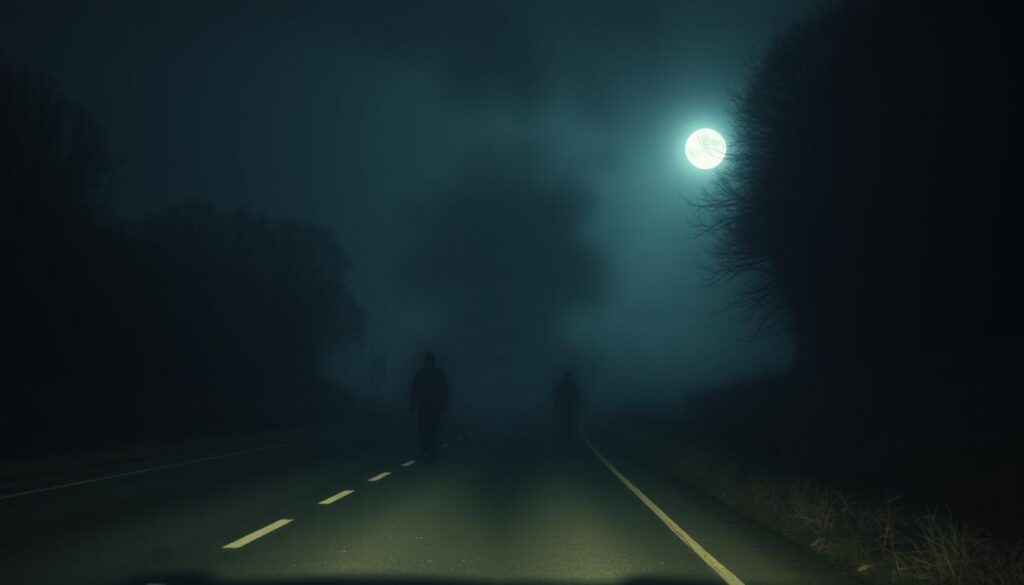
England’s landscapes are home to many haunted highways. These roads are known for eerie encounters and ghostly tales. The Vanishing Hitchhiker story is especially famous here.
The A229 connects Suffolk and Kent and is haunted by a ghost bride. She died on her way to her wedding. Drivers might see her ghost trying to hitch a ride.
The Stocksbridge Bypass, built in 1988, has a spooky history. Ghostly children were seen during its construction. Now, it’s a reminder of those stories. It’s a three-hour and fifteen-minute drive from London.
The M6 is known as the Bermuda Triangle of roads. It’s a Roman road over 2000 years old. Drivers have seen Roman soldiers and even cars vanish.
The Spaniard’s Inn in Hampstead is haunted by an eighteenth-century highwayman. It’s a place of history and ghost stories. It’s a hotspot for those interested in ghost sightings.
Traveling these haunted highways is an adventure. It connects you to England’s ghost stories and folklore. It’s a journey unlike any other.
Conclusion
The Vanishing Hitchhiker story is a fascinating part of British folklore. It links the past to the present through urban legends. For over two centuries, a young woman’s ghost in Aycliffe Village has both thrilled and scared people.
Her ghostly appearances along the Great North Road and other places have left a lasting mark. Each story adds to the urban legends’ impact on our culture. They show how these tales continue to captivate us.
These stories reflect our deep-seated fears and curiosity about the unknown. They have evolved but still hold onto their mystery and supernatural elements. This mix of old and new keeps the Vanishing Hitchhiker alive in our culture, drawing in new fans.
By diving into these legends, you join a timeless story that crosses borders and eras. Today’s technology lets us share our own ghostly encounters. This keeps the Vanishing Hitchhiker’s story alive, inviting you to explore your own haunted roads.
Let these spooky tales ignite your imagination. They promise to leave a lasting impression, ensuring their stories continue to thrill us for years.

